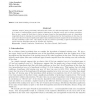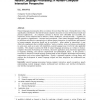2863 search results - page 21 / 573 » Computer modelling and natural phenomena |
BIOSYSTEMS
2008
13 years 7 months ago
2008
Telomere shortening provides a molecular basis for the Hayflick limit. Recent data suggest that telomere shortening also influence mitotic rate. We propose a stochastic growth mod...
GMP
2006
IEEE
14 years 1 months ago
2006
IEEE
Geodesic paths and distances on meshes are used for many applications such as parameterization, remeshing, mesh segmentation, and simulations of natural phenomena. Noble works to c...
COLT
2000
Springer
13 years 11 months ago
2000
Springer
Haussler, Kearns, Seung and Tishby introduced the notion of a shell decomposition of the union bound as a means of understanding certain empirical phenomena in learning curves suc...
AC
1998
Springer
13 years 7 months ago
1998
Springer
Natural language processing has been in existence for more than fifty years. During this time, it has significantly contributed to the field of human-computer interaction in terms...
NN
2006
Springer
13 years 7 months ago
2006
Springer
How does attention operate in natural scenes? We show that the receptive fields of inferior temporal cortex neurons that implement object representations become small and located ...


